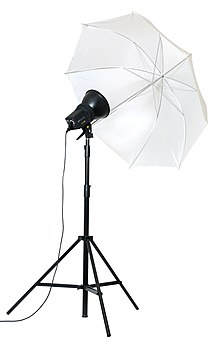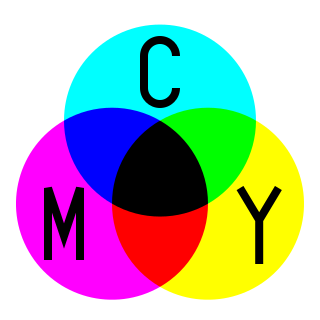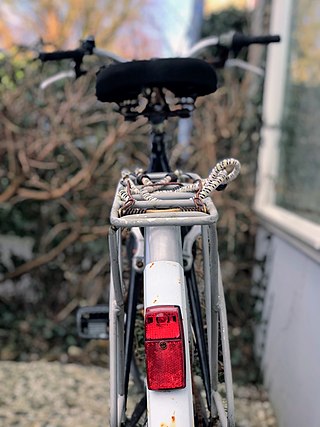
In photography and cinematography, a reflector is an improvised or specialised reflective surface used to redirect light towards a given subject or scene.

In photography and cinematography, a reflector is an improvised or specialised reflective surface used to redirect light towards a given subject or scene.
Apart from certain highly specialized components found in enlargers, projectors and scanners, photographic reflectors fall into two main groups:


Similar to a domestic lampshade, these reflectors are fixed to an artificial light source (for example, a filament bulb or flash tube) to direct and shape the otherwise scattered light, reflecting it off their concave inner surfaces and directing it towards the scene to be photographed. Although there are a large number of variants, the most common types are:
The reflector factor is the ratio of the illumination provided by a lamp fitted within a reflector to the illumination provided without any reflector fitted. A matte reflector will typically have a reflector factor of around 2, due to its more diffuse effect, while a polished or metallic-finished reflector may have a factor of up to 6. [1]
Also known as plane reflectors, "flats" or bounce boards, this kind of reflector is located independent of a light source; the light is reflected off its surface, either to achieve a broader light source, or control shadows and highlights, or both. This kind of reflector generally has a very low reflectivity factor that varies widely according to surface texture and colour. [2] As a result, it is most commonly used to control contrast in both artificial and natural lighting, in place of a fill light or "kick" light. In this case, light "spilling" from the main ambient or key light illuminating a scene is reflected back into the scene with a varying degrees of precision and intensity, according to the chosen reflective surface and its position relative to the scene.
Reflectors may also be used as a means of increasing the size of the main light source, which may (or may not) retain a direct path to the scene. By positioning a board reflector close to a light source, its effective size can be increased by "bouncing" the light off it. [3] A very common example of this technique is the traditional umbrella reflector, invented by George Larson, [4] typically having a gold, silver or matte white interior onto which a lamp fitted with a circular reflector is projected, providing a broad, soft illumination. The lamp faces away from the scene to be photographed, allowing only reflected light to be thrown forward. Types of Reflector. 1 Dispersive reflector. 2 Holophane. 3 optical combination 4 concentrating 5 Angle.

Reflectors vary enormously in size, colour, reflectivity and portability. In tabletop still life photography, small mirrors and card stock are used extensively, both to reduce lighting contrast and create highlights on reflective subjects such as glassware and jewelry. Larger-scale subjects such as motor vehicles require the use of huge "flats", often requiring specialised motorized winches to position them accurately.
Location photography calls for much more portable materials and a large range of lightweight, folding reflectors are commercially available in a variety of colors.
Photographers make regular use of walls, ceilings and even entire rooms as reflectors, especially with the interior of buildings which may lack sufficient available light. Often known as "bounce flash" photography, but equally common with Tungsten lights in cinematography. Used extensively throughout film history, in 1956 Subrata Mitra further pioneered the technique with the use of large scale diffusers to match studio lighting with location shooting. [5] [6]
The area to be photographed is lit by walls off-camera, which then provide illumination similar to that of a large window. When "bounced" off a ceiling, the lighting resembles that of fluorescent tubes. As this very broad, flat lighting is more typical of an overcast day outdoors, a more realistic interior illumination is achieved by reducing the power of additional lighting relative to the available light, so that either source may act as a fill to the other. Hence bounce lighting may provide either the primary or secondary (fill) light source, depending on its intensity.
Walls also make ideal reflectors outdoors, reflecting sunlight back upon a subject and reducing shadows (and hence overall contrast) according to the color, size and proximity of the wall. A more readily available alternative is the portable, lightweight, collapsible reflector, commercially available in a range of sizes and colors, or improvised using a sheet of card stock or even a bed sheet. Stands may be erected to retain these reflectors, although it is often much more convenient and practical to have an assistant hold and move them.[ citation needed ]

In 3D computer graphics, radiosity is an application of the finite element method to solving the rendering equation for scenes with surfaces that reflect light diffusely. Unlike rendering methods that use Monte Carlo algorithms, which handle all types of light paths, typical radiosity only account for paths which leave a light source and are reflected diffusely some number of times before hitting the eye. Radiosity is a global illumination algorithm in the sense that the illumination arriving on a surface comes not just directly from the light sources, but also from other surfaces reflecting light. Radiosity is viewpoint independent, which increases the calculations involved, but makes them useful for all viewpoints.

A Fresnel lens is a type of composite compact lens developed by the French physicist Augustin-Jean Fresnel (1788–1827) for use in lighthouses. It has been called "the invention that saved a million ships."

A light meter is a device used to measure the amount of light. In photography, a light meter is used to determine the proper exposure for a photograph. The meter will include either a digital or analog calculator which displays the correct shutter speed and f-number for optimum exposure, given a certain lighting situation and film speed. Similarly, exposure meters are also used in the fields of cinematography and scenic design, in order to determine the optimum light level for a scene.

A flash is a device used in photography that produces a brief burst of light at a color temperature of about 5500 K to help illuminate a scene. A major purpose of a flash is to illuminate a dark scene. Other uses are capturing quickly moving objects or changing the quality of light. Flash refers either to the flash of light itself or to the electronic flash unit discharging the light. Most current flash units are electronic, having evolved from single-use flashbulbs and flammable powders. Modern cameras often activate flash units automatically.
In photography, light value has been used to refer to a "light level" for either incident or reflected light, often on a base-2 logarithmic scale. The term does not derive from a published standard, and has had several different meanings:

A flashlight or torch is a portable hand-held electric lamp. Formerly, the light source typically was a miniature incandescent light bulb, but these have been displaced by light-emitting diodes (LEDs) since the mid-2000s. A typical flashlight consists of the light source mounted in a reflector, a transparent cover to protect the light source and reflector, a battery, and a switch, all enclosed in a case.

Subtractive color or subtractive color mixing predicts the spectral power distribution of light after it passes through successive layers of partially absorbing media. This idealized model is the essential principle of how dyes and inks are used in color printing and photography where the perception of color is elicited after white light passes through microscopic "stacks" of partially absorbing media allowing some wavelengths of light to reach the eye and not others.

Bicycle lighting is illumination attached to bicycles whose purpose above all is, along with reflectors, to improve the visibility of the bicycle and its rider to other road users under circumstances of poor ambient illumination. A secondary purpose is to illuminate reflective materials such as cat's eyes and traffic signs. A third purpose may be to illuminate the roadway so that the rider can see the way ahead. Serving the latter purposes require much more luminous flux and thus more power.

A gobo is an object placed inside or in front of a light source to control the shape of the emitted light and its shadow.

A soft box is a type of photographic lighting device, one of a number of photographic soft light devices. All the various soft light types create even and diffused light by transmitting light through some scattering material, or by reflecting light off a second surface to diffuse the light. The best known form of reflective source is the umbrella light, where the light from the bulb is "bounced" off the inside of a metalized umbrella to create an indirect "soft" light.

Ellipsoidal reflector spot is the name for a type of stage lighting instrument, named for the ellipsoidal reflector used to collect and direct the light through a barrel that contains a lens or lens train. The optics of an ERS instrument are roughly similar to those of a 35 mm slide projector.

The sulfur lamp is a highly efficient full-spectrum electrodeless lighting system whose light is generated by sulfur plasma that has been excited by microwave radiation. They are a particular type of plasma lamp, and one of the most modern. The technology was developed in the early 1990s, but, although it appeared initially to be very promising, sulfur lighting was a commercial failure by the late 1990s. Since 2005, lamps are again being manufactured for commercial use.

In television, film, stage, or photographic lighting, a fill light may be used to reduce the contrast of a scene to match the dynamic range of the recording media and record the same amount of detail typically seen by eye in average lighting and considered normal. From that baseline of normality, using more or less fill will make shadows seem lighter or darker than normal, which will cause the viewer to react differently, by inferring both environmental and mood clues from the tone of the shadows.

Hard and soft light are different types of lighting that are commonly used in photography and filmmaking. Soft light is light that tends to "wrap" around objects, projecting diffused shadows with soft edges, whereas hard light is more focused and produces harsher shadows.

Stage lighting instruments are used in stage lighting to illuminate theatrical productions, concerts, and other performances taking place in live performance venues. They are also used to light television studios and sound stages.
In optics, a diffuser is any material that diffuses or scatters light in some manner to transmit soft light. Diffused light can be easily obtained by reflecting light from a white surface, while more compact diffusers may use translucent material, including ground glass, teflon, opal glass, and greyed glass.

The Electronic Theatre Controls (ETC) Source Four is an ellipsoidal reflector spotlight (ERS) used in stage lighting. First released in 1992, the Source Four was invented by David Cunningham and features an improved lamp and reflector compared to previous ERS designs, tool-free lamp adjustment, and a rotating, interchangeable shutter barrel. The Source Four is widely used by professional theaters across the globe.

In photography and cinematography, available light refers to any available source of light that is not explicitly supplied by the photographer for the purpose of taking pictures. The term usually refers to light sources in the surrounding environment that are present naturally or artificial lighting that are already pre-existing. It generally excludes flashes, although arguably flash lighting provided by other photographers shooting simultaneously in the same space could be considered available light. Light sources that affect the scene and are included in the actual frame are called practical light sources, or simply practicals.

Photographic lighting refers to how a light source, artificial or natural, illuminates the scene or subject that is photographed. Photographers can manipulate the positioning and the quality of a light source to create visual effects, potentially changing aspects of the photograph such as clarity, tone and saturation to create an accurate rendition of the scene.
A monolight is a self-contained photographic flash lighting unit usually found in a studio. Each monolight has its own independent power source. It does not depend on a centralized power supply as a "pack and head" system does. Monolights are also independently controlled: each has its own power settings and light output. Flash power is predominantly measured by the industry in watt seconds, which is unit-equivalent to the joule.